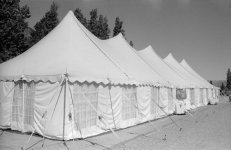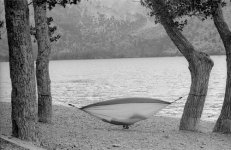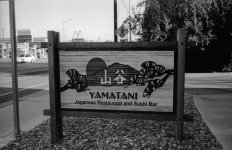newtorf
Established
Recently I've developed a few rolls of Arista Premium 400 (rebranded Tri-X) that I shot in 2016 and put away on shelf without freezing. The expiration date of the films is 2013 -- they had always been frozen before I shot them.
I tried normal development for several rolls and pull development two rolls (just curious) in the past week but the results were just "boring" (a.k.a. normal). So yesterday I decided to experiment stand development with HC-110.
It has been well established that one roll of 36 exp 35mm film requires minimal 3ml HC-110 syrup for one shot development. Typically, I used dilution H and made 480ml developer solution from 7.5ml syrup. This solution allowed me to develop two rolls of 36 exp 35mm film in a 500ml stainless steel tank. It had worked very well in the past.
Call me cheap, I have always been wondering whether it is possible to use even less syrup, which would cut my negligible cost on the developer even further! I know many of you probably are already rolling your eyes at me. That's OK. Heck, even if it fails, it's just a small lesson of don't be cheap!
The true reason to use even less syrup is to make further dilution and still fit into the 500ml stainless steel tank. So after researching a lot online with no conclusive result, I decided to conduct an experiment yesterday.
I diluted 5ml syrup into 500ml developer AND soaked two rolls of 36 exp 35mm films. The temperature at the beginning of the development was 70F. After initial agitation of 30 seconds, I put the tank in the refrigerator for 40 minutes. At 20 minutes mark, I gently agitated the tank twice.
The result floors me! The contrast, the well-controlled highlight, the deep shadow, and the grain are among the best I've ever got out of Tri-X. The pictures really shine in front of the other rolls developed last week. The only flaw that I can see is some small highlight at the edge of some pictures, which looks like a bit light leak. I got this similar issue a few years ago when I tried stand development with Rodinal. Haven't figured out how to solve it.
At this moment, it is hard to say whether it's because the subjects of these two rolls were well thought through to make the pictures stand out, or the development method is the magic bullet. But I will definitely try this method again -- still have several rolls of Agfa APX 100 and Plus-X to go!
I tried normal development for several rolls and pull development two rolls (just curious) in the past week but the results were just "boring" (a.k.a. normal). So yesterday I decided to experiment stand development with HC-110.
It has been well established that one roll of 36 exp 35mm film requires minimal 3ml HC-110 syrup for one shot development. Typically, I used dilution H and made 480ml developer solution from 7.5ml syrup. This solution allowed me to develop two rolls of 36 exp 35mm film in a 500ml stainless steel tank. It had worked very well in the past.
Call me cheap, I have always been wondering whether it is possible to use even less syrup, which would cut my negligible cost on the developer even further! I know many of you probably are already rolling your eyes at me. That's OK. Heck, even if it fails, it's just a small lesson of don't be cheap!
The true reason to use even less syrup is to make further dilution and still fit into the 500ml stainless steel tank. So after researching a lot online with no conclusive result, I decided to conduct an experiment yesterday.
I diluted 5ml syrup into 500ml developer AND soaked two rolls of 36 exp 35mm films. The temperature at the beginning of the development was 70F. After initial agitation of 30 seconds, I put the tank in the refrigerator for 40 minutes. At 20 minutes mark, I gently agitated the tank twice.
The result floors me! The contrast, the well-controlled highlight, the deep shadow, and the grain are among the best I've ever got out of Tri-X. The pictures really shine in front of the other rolls developed last week. The only flaw that I can see is some small highlight at the edge of some pictures, which looks like a bit light leak. I got this similar issue a few years ago when I tried stand development with Rodinal. Haven't figured out how to solve it.
At this moment, it is hard to say whether it's because the subjects of these two rolls were well thought through to make the pictures stand out, or the development method is the magic bullet. But I will definitely try this method again -- still have several rolls of Agfa APX 100 and Plus-X to go!























